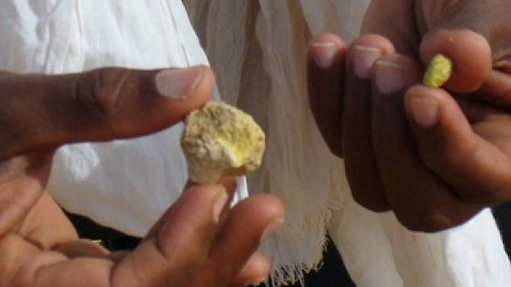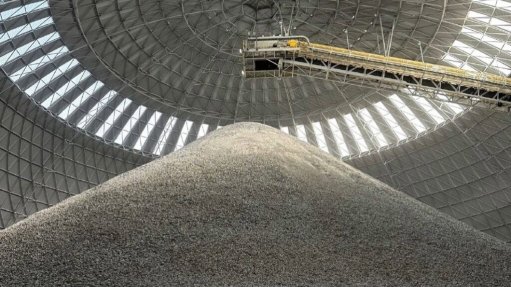Copper industry advocating antimicrobial copper use and combating theft
The Copper Development Association Africa (CDAA) states that it expects a growth of about 4% in copper production, owing to an increase in demand for the base metal, as a result of project roll-outs across Africa and the many uses of copper being realised worldwide.
“Africa has the best ore grades of any copper mine in the world. It is expected, internationally, that Africa will experience the most growth over the next ten years, with the potential to produce 2.8-million tons of copper a year by 2022,” states CDAA centre director Evert Swanepoel.
The copper industry has experienced substantial growth in 2012. “Overall, the South African copper industry is doing well, owing to the general development of its downstream sector. The expansion of electricity infrastructure has also played a role,” he points out.
The continent also has the highest proportion of strong projects over this period. “It is estimated that Africa will represent 17% of new mine supply worldwide over the next ten years. Considering that Africa comprises only 9% of the world’s copper market, it is a considerable growth,” Swanepoel highlights.
He further notes that Zambia and the Democratic Republic of Congo (DRC) are experiencing the most growth with regard to copper development. “Zambia currently produces about 4% of the world’s copper supply and has earmarked projects to the value of 570 000 t/y of copper. In addition, the DRC has acquired projects to the value of 370 000 t/y.”
Swanepoel warns that a threat to the growth of the copper industry in Africa is resource nationalism, which might see governments nationalise mines. Poor infrastructure development also hinders copper-industry growth.
“In addition, a worldwide fear of political uncertainty regarding Africa and the lack of a skilled workforce could further pose threats to its growth,” he adds.
Growth Areas
The CDAA is advocating the use of copper in hospitals, particularly public hospitals, through its antimicrobial copper initiative. “Copper kills bacteria and the CDAA has done extensive laboratory and field tests with copper and its antibacterial nature has been proved worldwide,” he states.
The problem of hospital-acquired infections is prevalent in South Africa and the CDAA has been trying to introduce antimicrobial copper to government hospitals, with no response from government, Swanepoel adds.
It was reported in the media that, in developed countries, about 5% to 10% of patients admitted to acute care in hospitals acquired an infection, which was not present or incubating on admission. The current rate for hospital-acquired infections in developing countries might exceed 25%.
Swanepoel notes that 80% of infections are distributed through the touching of surfaces, such as door handles, bedside tables and bed rails. “If you touch an infected surface, the next seven surfaces will also be infected until the bacteria is worn out.”
With antimicrobial copper solutions, the copper is placed over the surface of certain appliances. When bacterium comes into contact with the copper surface, it is destroyed within two hours as the copper breaks down its outer cell.
He notes that the CDAA has implemented its antimicrobial copper solution at two hospitals, in Palaborwa, Limpopo, and at a veterinary operating room and dental surgery, in Alberton, Gauteng. A remark- able reduction in hospital-acquired infections have been realised at these practices.
“While it is expensive to implement anti- microbial copper at a hospital, significant cost savings will be realised in the long term, as patients who acquire a hospital-related infection spend about 21 more days in hospital, resulting in major expenses for South Africa’s healthcare system.”
Swanepoel notes that, should the appearance of copper in public hospitals be problematic, owing to the trend of copper theft in South Africa, the CDAA supplies copper that looks similar to stainless steel.
The CDAA implemented its antimicrobial solution in hospitals in Zambia and will install its copper solution at a hospital’s burn unit, as burn victims are very susceptible to infections.
“When people start to realise the antibacterial nature of copper, it will increase demand for the metal,” he states, highlighting that the increased demand for copper in Zambia’s health sector would lead to a more active downstream sector for the country.
The CDAA is also creating copper fishing nets, in Richards Bay, in South Africa, and Mozambique, owing to copper’s antimicrobial properties. “Conventional fishing nets clog quickly, leading to poor water circulation and poor oxygen levels, which results in the fish developing diseases or dying,” Swanepoel explains.
Micro-organisms, however, do not stick to copper, which means that the mesh stays clean, improving the flow of water and allowing the fish to grow bigger, he adds, highlighting that the CDAA has undertaken extensive research in this regard and should have antimicrobial copper nets available to Africa’s aquaculture industries by May this year.
“Aquaculture is considered worldwide as the fastest-growing industry, which is posi- tive for the copper industry,” Swanepoel highlights.
During the last two decades, there has been a rapid global expansion of commercial aquaculture and it currently contributes significantly to total worldwide seafood production.
Some aquaculture methods are better than others; for example, the farming of mussels and oysters, as is practised in South Africa, is regarded as a good environmental seafood choice, as these animals are filter feeders and do not need any nutritional input, the WWF reports.
Copper Theft
The biggest challenge that South Africa’s copper industry needs to overcome is copper theft, Swanepoel urges. “Theft has a major impact on the copper industry, as it destroys confidence in the use of copper and results in search for substitutions.
“The damage done to infrastructure is enormous and could be life threatening.”
Currently, there is a huge demand overseas, particularly from China, for South Africa’s scrap metal, such as copper. Government is trying to retain some of the scrap metal by means of a pricing difference.
He notes that some recycling dealers are turning a blind eye to stolen copper and stronger regulations are needed to ensure that the market for stolen copper is eradicated.
“The CDAA is urging better admini- stration and better inspection of goods through the Second-hand Goods Act,” notes Swanepoel, adding that this approach might be working.
The South African Chamber of Commerce and Industry (Sacci) stated in a June 2012 report that the amount of copper stolen in South Africa had decreased from R27-million in April to R23-million in May.
Sacci introduced a new scale to measure copper theft – the copper theft volume indicator – in November 2012, CEO Neren Rau said.
“This provides a volume estimate of the copper stolen, which strips away the possible inflationary bias of high copper prices in a given month and provides an estimate in terms of tons of copper stolen.”
According to this indicator, 356 t were stolen in May 2012, almost 16% less than the previous month.
Swanepoel adds that the CDAA is advo- cating that the use of cash in the copper industry be scrapped, as it eases the occurrence of fraud and theft.
Further, the CDAA notes that it is facing the dumping of inferior copper products in South Africa from countries such as China and India. “Copper tubing of inferior quality is being dumped in South Africa, which is bought by some of the major retail chains and sold to consumers and con- tractors. This inferior tubing is used in buildings and it fails quite often,” Swanepoel warns.
Therefore, the CDAA is implementing antidumping measures, in collaboration with the International Trade Administration Commission of South Africa, and it will continue with its efforts until government realises the viability of implementing an import tax on copper products manufactured in South Africa.
In addition, imported substandard elec- trical cables and appliances, which are a financial problem and a safety hazard, are negatively impacting the copper industry. “Many of the electrical fires in homes start as a result of substandard electrical cables and appliances bought by consumers,” he notes.
Swanepoel adds that, while the South African Bureau of Standards (SABS) should ensure that products sold to con- sumers are up to standard, it cannot force consumers to buy products that are SABS approved.
Owing to inferior products’ cheap prices, many consumers opt for these appliances. “Therefore, the copper industry is adver- tising and urging consumers to look for SABS approval standards when purchasing products. The association is also engaging with the Electrical Contractors Board, hosting conferences and inviting people to attend and acquire information on the SABS standards.”
Comments
Press Office
Announcements
What's On
Subscribe to improve your user experience...
Option 1 (equivalent of R125 a month):
Receive a weekly copy of Creamer Media's Engineering News & Mining Weekly magazine
(print copy for those in South Africa and e-magazine for those outside of South Africa)
Receive daily email newsletters
Access to full search results
Access archive of magazine back copies
Access to Projects in Progress
Access to ONE Research Report of your choice in PDF format
Option 2 (equivalent of R375 a month):
All benefits from Option 1
PLUS
Access to Creamer Media's Research Channel Africa for ALL Research Reports, in PDF format, on various industrial and mining sectors
including Electricity; Water; Energy Transition; Hydrogen; Roads, Rail and Ports; Coal; Gold; Platinum; Battery Metals; etc.
Already a subscriber?
Forgotten your password?
Receive weekly copy of Creamer Media's Engineering News & Mining Weekly magazine (print copy for those in South Africa and e-magazine for those outside of South Africa)
➕
Recieve daily email newsletters
➕
Access to full search results
➕
Access archive of magazine back copies
➕
Access to Projects in Progress
➕
Access to ONE Research Report of your choice in PDF format
RESEARCH CHANNEL AFRICA
R4500 (equivalent of R375 a month)
SUBSCRIBEAll benefits from Option 1
➕
Access to Creamer Media's Research Channel Africa for ALL Research Reports on various industrial and mining sectors, in PDF format, including on:
Electricity
➕
Water
➕
Energy Transition
➕
Hydrogen
➕
Roads, Rail and Ports
➕
Coal
➕
Gold
➕
Platinum
➕
Battery Metals
➕
etc.
Receive all benefits from Option 1 or Option 2 delivered to numerous people at your company
➕
Multiple User names and Passwords for simultaneous log-ins
➕
Intranet integration access to all in your organisation


















